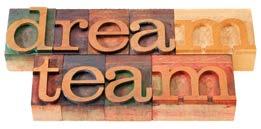TEAMS THAT WORK Rachelle Lee
©iStockphoto.com/marekuliasz
Create a
I
magine your day filled with amazing teamwork . . . what would that be like?
3. Individual team members seek to be of service to each other and the team. 4. People hold themselves accountable for their attitude, their contribution, learning opportunities, and their mistakes.
If you’re one of the lucky ones to have that situation daily at work or in other arenas of your life, then you know what it feels like to be a part of highly productive and rewarding teamwork.
5. Team members celebrate each other’s accomplishments and are happy to see their teammates succeed.
Individuals who work in teams that function well together have more enjoyment and a greater sense of accomplishment. They thrive on being efficient and innovative and are very effective at producing high-quality and a high-quantity of results. They feel supported by being in a group “community” because there’s concern for the mutual benefit of the group as well as the individuals and they have a great sense of contribution to something bigger than themselves; they take pride in doing their part.
Individuals who work in teams that function well together have more enjoyment and a greater sense of accomplishment. In his excellent book The Five Dysfunctions of a Team (Jossey-Bass, 2002), Patrick Lencioni identifies the Five Dysfunctions that inhibit a team’s success. In all my years of practice as an organizational development consultant, I have found Lencioni’s model of teams provides the most relatable, practical, and simple understanding of why teams fail and what to do about it.
As a result, team members feel valued for their contribution and they are motivated to support the success of other team members. 1. Everyone on the team feels their team members have the greater good at heart and intentions that are in the best interests of other individuals and the team as a whole. 2. Everyone develops innovative ideas together. Time spent as a team is energizing!
10
TABLE OF CONTENTS
Copyright Patrick Lencioni
What constitutes good teamwork?
His book is written as a fable, making it easy to read and understand through the telling The Society of Notaries Public of British Columbia
of a story about a new CEO who has been hired to save a company from failure. While Lencioni’s model is true-to-life and simple to understand, the hard work for leaders comes in deciding to make a change and taking the consistent actions required to create lasting change.
What are the Five Dysfunctions of a Team? Dysfunction #1: Absence of Trust (Resulting Problem: Invulnerability) Trust is the base for creating an effective team When team members are reluctant to be vulnerable with one another and are unwilling to admit their mistakes and weaknesses or to ask for help, there is absence of trust among team members. Lack of trust is also created by a perceived need for self-preservation.
Dysfunction #2: Fear of Conflict (Resulting Problem: Artificial Harmony) High-performing teams engage in healthy conflict and passionate debate about issues that are important to the team. Teams that lack trust are unable to engage in unfiltered debate about key issues. In that environment, inferior decisions are made because team members withhold their ideas and opinions for fear they may be misinterpreted and thus contribute to unwarranted personally charged conflict. Volume 26 Number 1 Spring 2017






























